DES THÉS

 Lucile Block de Friberg Communications Manager
Lucile Block de Friberg Communications Manager



 Lucile Block de Friberg Communications Manager
Lucile Block de Friberg Communications Manager

All our senses are involved when we drink a tea or herbal infusion. Starting with the texture and weight of the cup in our hands, then the aromas that emanate from it and the beauty of the liquid with all its colors and flavors, warmth or freshness, followed by the feeling of contentedness as we take time to appreciate each sip. Everything comes together to help us reconnect with our emotions. The sensory experience of tea takes us on an inner journey and is a source of wellbeing.
At Palais des Thés, we love to take time to replenish ourselves with tea, while trying to create the conditions that help us feel relaxed and calm.
Everyone has their own practices or rituals that keep them grounded and give them some time for themselves. Whether it is meditation, yoga, walking, creative hobbies or running, it is not a magic formula but a belief that wellbeing cannot be defined but it can be experienced, and we can help promote it.
Cover
The tea bushes are deliberately kept low to make it easier to pick the leaves. This forms what is known as the “plucking table”.
opposite
Traditionally, different brewing methods are used for different types of tea leaves. Here, the leaves are repeatedly steeped in the cup to release their aromas and flavors into the water.
For us, plants are valuable allies in this holistic quest. They can soothe, energize, relax, and even regulate our emotions.
They can help us focus, dream, calm down, or feel full of optimism. We are constantly inspired by these benefits and the way they activate our five senses.
This summer, let’s take the time to feel replenished with tea.
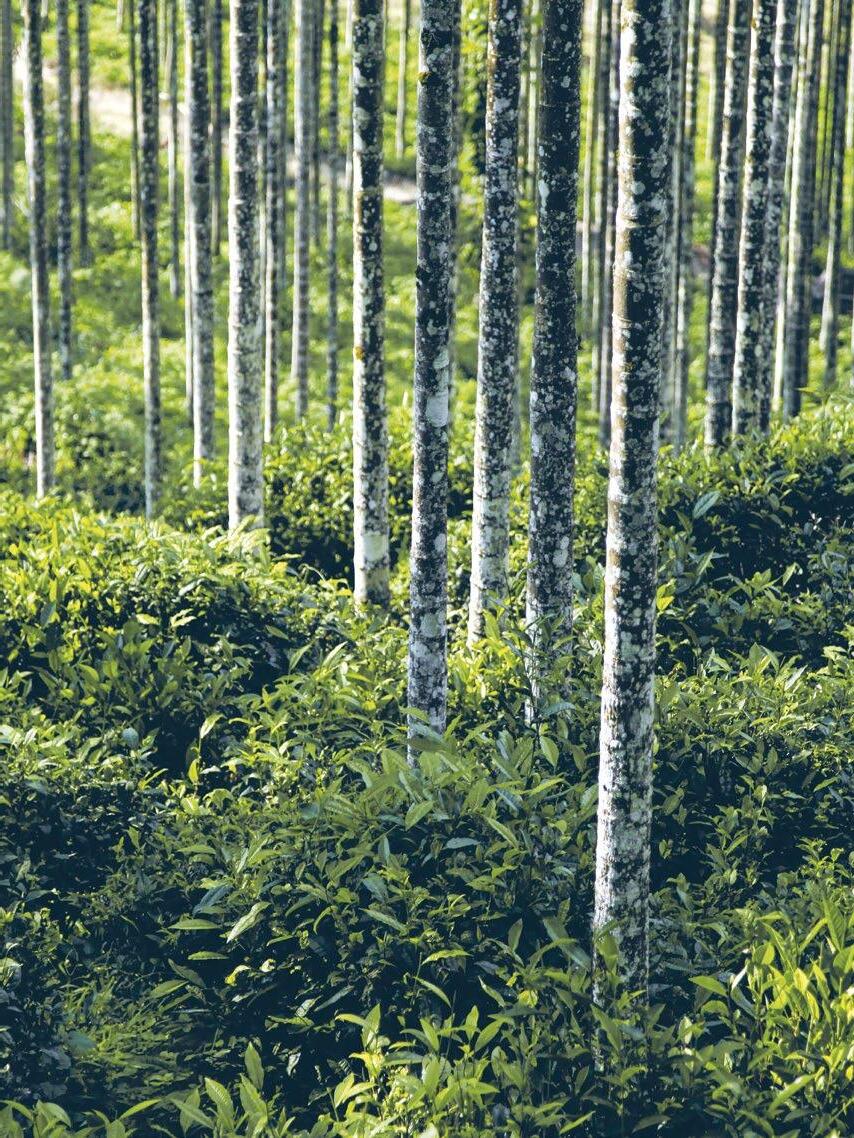
Laurence Bidoire
Laurence is passionate about all things fragrance. She joined Palais des Thés in 2019. A Master Tea Sommelier, she manages the store on Rue de l’Annonciation in Paris (16th arrondissement).

François-Xavier Delmas
François-Xavier is the founder of Palais des Thés and one of the world’s most renowned tea experts. He has been traveling the world’s tea plantations for over thirty years.

Elena Di Benedetto
Elena loves to spend her day writing about and drinking tea. A fan of Taiwanese Oolongs, she sees each cup as an opportunity for a change of scenery, with discoveries that feed her passion for tea.


There are very few tea-growing countries in South America. But some are home to some very special teas that are well worth seeking out. I’m taking you to a place near La Cumbre in Colombia, to visit the country’s only tea plantation.
By François-Xavier DelmasIwas worried about landing in Bogota because of the altitude, but what’s a mere 2,500 meters? It’s above 3,000 or 3,500 meters that you really start to feel it! The pilot pointed out the mountains as we began our descent. What luck to be invited into the cockpit by a crew who love tea! It was dark when we landed and I could just make out the peaks surrounding the capital, their shadowy shapes illuminated by the city and the moon. It’s hard to imagine a better introduction to Colombia.
I didn’t hang around in the city, as the next day I set off for Cali, home of salsa. Santiago was there to meet me. The region had suffered severe flooding and the heavy rains had only just stopped. I’d met Santiago several times in Paris, and he’d convinced me to visit the tea plantation he works for. It’s the only one in Colombia. This country will be my first stop before I travel further south to Peru, to meet other producers.
The Cauca Valley was once known for its sugar cane. Today, coffee and cocoa are among the region’s most famous crops.
From Cali, it’s a good hour’s drive to reach the plantation. This gave my friendly host time to tell me more about La Cumbre, at an altitude of 2,000 meters. Its camellia seeds arrived from Sri Lanka sixty years ago, and now there are 136 acres of tea fields on an estate of nearly 500 acres. “Here, we’re on the western side of the Andes,” he said cheerfully. He went on to tell me that the reason there is only one plantation left in Colombia today is that other attempts in various parts of the country have failed. Santiago praised the beauty of La Cumbre, a model of harmony with nature, he told me, before turning to me to make sure my arms were covered. “Mosquitoes…” he said, his words tailing off. A few more twists and turns, a magnificent view, forests, the first tea bushes, and then as we came round a bend, he pulled up sharply. Ahead of us, a table had been set up on the road itself. It was the most delightful of ambushes. Two women greeted me, their music blaring. They had brought some of the country’s most exotic fruits, and of course tea, several types, whose colors could be admired in a variety of transparent teapots. Santiago introduces me to Lina and Maria. As for me, Santiago decided that I was to be known by my Basque name, Patxi. We sipped tea, danced a bit, laughed a lot, and ate the delicious fruit. It was the first time
I’ve ever eaten some of them. There were sapotes, yellow dragon fruit, cherimoyas, passion fruit and physalis. “An antidepressant,” Lina tells me with a laugh. When we’d eaten everything down to the last pomegranate and the last gulupa, when we’d danced some more, drunk some more tea, and admired the landscape with the Pacific on the distant horizon, we set out to find Carlota.
Carlota is the heart and soul of the plantation, which has been in the same family since day one. She lives surrounded by the small botanical garden she has planted with giant tree ferns, orchids and the most incredible flowers. She is at one with this idyllic place. She told me the name of every flower and every plant, recognized the birds by their songs, swooned at every wonder of nature, and made us stop and listen at the slightest rustle. A few minutes later she asked us to follow her into the jungle, machete in hand, boots on our feet, to the source of life, the source of her love for this place, this dense tangle of forest where it’s almost impossible to advance without getting tangled in the vegetation or falling into water. Carlota and her beloved jungle. So as not to disturb this untamed forest, the tea fields are laid out in small plots of 5-12 acres, forming islands of cultivation. She doesn’t allow larger plots because they wouldn’t fit in with the geography of her heart. Where would birds nest if there were no undergrowth, bushes or trees?
And how can tea plants grow without being hindered by nature? Here, tea adapts to the forest, not the other way round. For Carlota, this is obvious. It is also natural to her that the plantation achieved organic certification long ago, that it is carbon neutral thanks to its solar panels, and that nothing can happen on the land unless it is sustainable. Carlota has entrusted the day-to-day running of the estate to other family members and dedicates herself to the community through her foundation. She started telling me about it, then stopped abruptly. She had heard the call of a motmot, then pointed out the hint of violet coloring the sky.
Life in these mountains has not always been easy. The FARC (the Revolutionary Armed Forces of Colombia) came to the region and their brutal killings claimed many victims. This went on for several decades. Carlota lost a brother in the attacks, but her family never left the place, never left the forest, never left the tea. They never left the villagers they love and with whom they share a difficult past. Then there is Claudio, the man behind the remarkable teas. We met him in the immaculate factory, which has a wonderful tasting room overlooking the mountains. The teas he offered me to taste included Colombia Oscuro, Andean White Tea, and Andean Green Tea. He also took advantage of my presence to prepare tastings of the various teas he had recently produced. This young, passionate man might try to make an Oolong one day, and another type of tea the next. He immerses himself in his subject. He changes the parameters one by one when making a tea to understand the consequences of each action on the aromas and textures. He’s also interested in dark teas. Curious and
Here, tea adapts to the forest.


Carlota’s plantation follows organic farming methods. The plots are no larger than 12 acres to protect the biodiversity of the area.
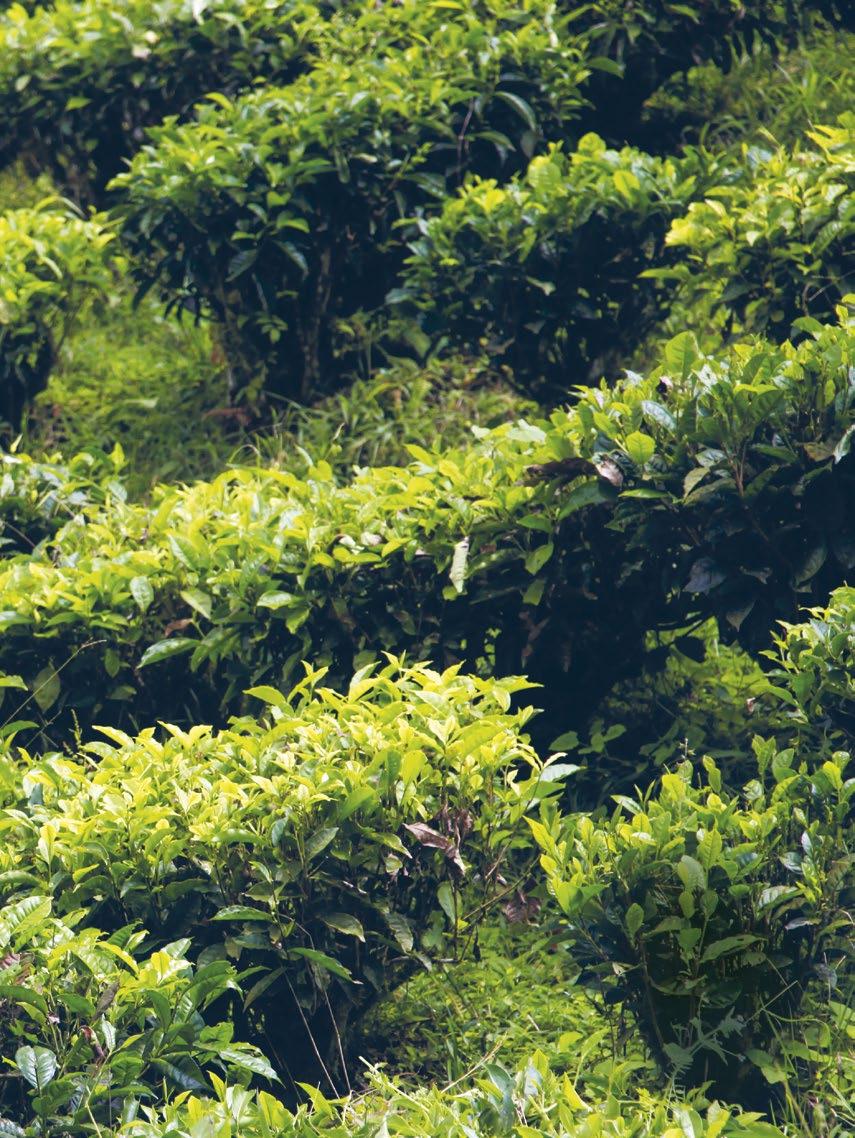
modest, he watched me closely as I tasted, anxious to know what I thought. I could read his love of tea on his face, in every movement he made, in the care with which he handled the tea leaves, to which he devotes all his time.
Here, surrounded by enthusiasts, men and women who are both professional and generous, of rare hospitality, you feel part of a family. Later, we all gathered in the communal house for the evening meal, tucking into the tuber soup, plantains stuffed with cheese and cornbread. Before that, I learned how they make their own compost from cow dung, and how they weed in the simplest way, without any effort, thanks to their flock of sixty sheep. I also learned that Carlota hadn’t told me half of what she does for the children of the village. She pays for their higher education when they are lucky enough to be offered a place at university but the family does not have the resources to fund their education or accommodation.
Carlota supports the younger children by offering English classes, educational programs and even Taekwondo classes. The kids love it. And so do their parents.
The next day, before hitting the road, I immersed myself once more in the jungle and the tea plants, breathing in the humid sea air brought by the west wind. Then I was back in Cali, on the slopes
Left to right
The tea economy allows an entire community to remain in the mountains, preserving its unique and fragile environment.
The life of Carlota, who runs the country’s only plantation, is guided by her love for the nature in which she has chosen to live.

of the San Antonio barrio, wandering through the ramshackle neighborhood that recalls a painful past – that of sugar cane and the slaves brought from Africa in atrocious conditions – and I thought of Carlota, Lina and Maria. Of Claudio and Santiago. I still had the taste of each tea in my mouth, the textures and aromas. The jasmine covering the walls, the oleander, and the frangipani reminded me of the rare orchids, anthuriums, and water lilies I had seen just the day before. I thought about Carlota’s generosity and Claudio’s donations, and how this La Cumbre tea estate has a bright future ahead of it, and how it deserves to be talked about here. •

To learn more about some exceptional Colombian teas, join François-Xavier Delmas and Sidonie Bonnec on an audio journey to this idyllic place where tea bushes, flowers, fruit, and birds flourish under Carlota’s watchful eye. The podcast Un thé, un voyage is available in French only.

People all over the world have always had an intuitive knowledge of the benefits of local plants, giving them a special place in traditional cooking, traditional medicine, purification rituals and skincare. As part of this holistic approach to wellbeing that is so important to us today, we find healthy, natural, and flavorsome herbal teas.
Since prehistoric times, hunter-gatherers have used plants for food and medicine. Archaeological excavations have shown that hemp, chamomile, flax and valerian, among others, were already known to early modern humans. In pre-Columbian civilizations, cinchona was known for its anti-malarial and anti-inflammatory properties, while curare was used as an anesthetic. This natural medicine was also believed to have sacred properties. A cuneiform tablet discovered in Mesopotamia, carved at the end of the third millennium BC, confirms that plants were used as food, medicine and psychotropic substances.
Over the centuries, these empirical practices were researched and classified as new scientific and botanical discoveries came to light, particularly as a result of explorations in different regions of the world. More and more specific properties were attributed to plants. The “holy healer”, Hildegard of Bingen (1098-1179), is considered to be the first natural therapist. The fifteenth century, the “century of plants”, saw the growth of botanical gardens. Europe’s pharmacopoeia was enriched by many native plants used for food and medicine. With the advent of phytochemistry in the eighteenth century, scientists defined the active ingredients of plants and isolated their properties. Today, with the advent of synthetic drugs, it is worth remembering that almost 70% of them are derived from natural substances (mainly plants, marine organisms, and micro-organisms), representing an incredible molecular diversity. The 350,000 plant species listed in the world are a unique source of molecules with therapeutic properties, although we know only 5% of the world’s flora 2! Plants still have many secrets to tell us.
73 % of 18-24 year olds and 71% of 25-34 year olds surveyed consume herbal teas compared to an average of 58% for all age groups1.
Legend has it that the birth of the botanical infusion can be traced back to 2737 BC when the Chinese emperor Chen Nong boiled a tea leaf in hot water for the first time. Infusion is a method of extraction which consists of immersing one or more plants (leaves, fruit, flowers, spices, etc.) in hot or iced water to extract the active ingredients, aromas and flavors. Naturally caffeine-free, hydrating and non-alcoholic, herbal infusions – provided they are not sweetened – can be enjoyed throughout the day.
The fast-growing herbal tea market, particularly for organic infusions, experienced a boom during the pandemic, driven by increased consumption of beverages at home and the desire to eat and drink more healthily, with carefully selected ingredients, for wellbeing.


Palais des Thés has been offering healthy, delicious, caffeine-free herbal teas for almost ten years. The Herboriste collection highlights aromatic plants known for their wellbeing benefits. Les Jardins brings together delicious blends that are as healthy as they are pleasurable to drink. Our Detox collection was created to showcase ingredients used in traditional herbal medicine around the world. In recent years, the quest for wellbeing has become more important to many of us. Although we all approach it in our own way, there is a general consensus on the benefits of mindful practices that help us achieve wellbeing in our daily lives. With this in mind, Palais des Thés has created Les Sources, an innovative collection of herbal teas designed to stimulate all the senses, inviting you to smell, look, taste, listen and feel. Each infusion combines the benefits of different plants and provides a source of positive sensations. Optimism, concentration, serenity and relaxation are within easy reach!
With this collection, Palais des Thés offers a holistic approach to wellbeing. Each herbal tea is accompanied by a multi-sensory experience accessible via a digital platform. Guided tastings, sound baths and wellbeing tips make this the ultimate wellness experience!

Herbal teas have become very popular with young people who appreciate this healthy, natural drink that can be enjoyed at any time of day. Easy to brew, they are perfectly suited to our modern lifestyles. To appeal to a younger market, players in the sector are rebranding and getting more creative with their concepts. For example, the renewed interest in the benefits of adaptogenic plants (see page 19) reflects a desire to create interesting new blends and offer solutions for wellbeing and relaxation. However, the market for plant-based foods is subject to very strict European regulations 3 •
25 %, growth in sales of Palais des Thés herbal teas between 2021 and 2022.
As a legacy of traditional herbalism, infusions combine the beneficial effects of plants and herbs on the mind and body with the pleasures of taste.
Plants develop substances (e.g. flavonoids, alkaloids, essential oils) called “active principles”, some of which are more concentrated than others. It is the synergy between the active molecules that gives the plant its therapeutic properties. The safety and quality of the plant depend on intrinsic (genetic) and extrinsic (environment, harvesting, cultivation, processing, transport, storage) factors. For herbal teas, it is therefore important that the plant is harvested in season and that it is dried, is not crushed, and is stored in optimal conditions to preserve its active ingredients. When steeped in water, these active principles are absorbed by the body. The real magic happens when these benefits are combined with a pleasurable sensory experience! The World Health Organization (WHO) has recognized the effects of plants such as chamomile, lemon balm, orange blossom, lime flower (linden) and verbena for their relaxing and/or sedative effects. Peppermint or rosemary, for example, have been studied for their ability to aid digestion.
Valeriana officinalis L.

Recommended by Hippocrates, this plant native to Europe and Central Asia is renowned for its calming and relaxing properties. It has been used since ancient times to relieve anxiety and promote sleep. It has sweet, spicy, and slightly bitter notes.
→ This ingredient can be found in On A Cloud in the new Les Sources collection of herbal teas.
Passiflora incarnata L.
The passionflower is native to South America and grew in the gardens of the Aztec emperors. It is said to help people fall asleep quickly and get a good night’s sleep. Often combined with other plants, it is used in many herbal remedies.
→ This ingredient can be found in On A Cloud in the new Les Sources collection of herbal teas.

Aspalathus linearis
Commonly known as red tea, rooibos is a member of the legume family. It does not contain caffeine. This South African plant has been consumed as a herbal tea by indigenous people for over 300 years, but has only been commercialized since the early 1930s. The infusion is made by oxidizing the leaves and stems, which gives the liquid its flavor and color.
Ilex paraguariensis
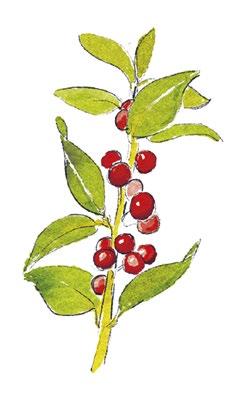
Mate, or yerba mate, is a popular infusion in South America. Yerba mate is a member of the holly family. The leaves are roasted and crushed to produce a stimulating, caffeine-rich drink.

Melissa officinalis

Recognized since the time of the ancient Greeks, lemon balm was recommended by Hippocrates for stomach pains and is said to calm the nervous system. The active ingredients in its leaves (e.g. triterpenes, flavonoids) are claimed to have relaxing and sedative effects. Its lemony scent comes from its essential oil.
→ This ingredient can be found in The Sound
Whether known as “elite plants” or “royal herbs”, some plants were known to increase physical and mental performance, reduce fatigue, improve resistance to disease, and promote longevity. These “tonics” were consumed by soldiers and hunters to prepare their bodies for long journeys.
In the 1950s, Drs. Nikolai Lazarev and Israel Brekhman sought to demonstrate the efficacy of the plants, berries, roots, and fungi that they grouped under the name “adaptogens”
(from the Latin adaptare meaning “to adapt” and the Greek genes for “produced by”). They were so named because of their effects on the body’s ability to adapt to various stresses. The doctors’ goal was to improve the performance of athletes and workers without compromising their health.
Adaptogens have three properties:
– A general effect on the body’s resilience,
– A normalizing effect that helps the body adapt to stress,
– A lack of toxicity (although their safety has not been proven).
When combined, they are said to have more powerful effects.

Schisandra chinensis (Turcz.) Baill.
The five-flavor berry (Wu Wei Zi) is a climbing plant native to China. It has been used in traditional Chinese medicine for thousands of years, especially for the tonic effects of its fruits. This adaptogenic plant is said to promote physical and emotional balance.
→ This ingredient can be found in The Sound Of Waves in the new Les Sources collection of herbal teas.
Ocimum tenuiflorum L.
Also known as holy basil or Thai basil, this medicinal plant is widespread in India, where it is grown near Buddhist temples. It has been used in Ayurvedic medicine for thousands of years. This adaptogenic plant contains antioxidants and is said to promote vitality.
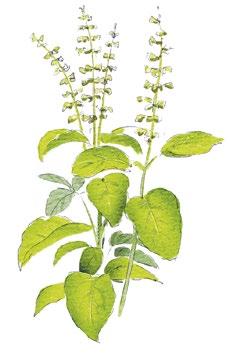
→ This ingredient can be found in Pure Joy in the new Les Sources collection of herbal teas.
Panax ginseng C.A. Mey

Native to China and Korea, this essential ingredient in traditional Chinese medicine is also known as the “flower of life” or “sovereign remedy”. It is an adaptogenic plant and contains over 150 active molecules.
→ This ingredient can be found in In My Bubble in the new Les Sources collection of herbal teas.

In Japan, tea is a matter of light and shade. There are two main categories of tea: “light-grown” teas, which are harvested from tea plants that have never been shaded, and “shade-grown” teas, produced using tea leaves intentionally partially deprived of sunlight. This causes them to draw more nutrients from the soil and develop a sweet and complex umami flavor in the cup.
By Laetitia PortoisTo shade the tea bush, it is covered with black cloth. It is called direct shade when the cloth is draped directly over the plants.

The history of shade-grown tea dates back to the mid-nineteenth century. In the 1830s, Kahei Yamamoto, a sixth-generation Edo tea merchant, introduced a new production method during a trip to Uji. He produced a green tea from bushes that had been covered with a blanket and deprived of sunlight for several weeks prior to harvest. This method was originally used to protect the plants from prolonged frost during a particularly long winter. Back in Edo, the tea’s unique flavor was a great success. The technique spread, and different types of shade-grown teas appeared. Depending on the length of the shade period, the material used to cover the tea plants, and the method of harvesting, the teas developed different notes and flavors. However, they all had one thing in common: the infusions had a particularly intense umami flavor (which is also found in light-grown teas).

Tea plants need sunlight for at least a few hours a day in order to grow and develop the essential oils that will give the infusion its flavor and aroma. When the plant is deprived of sunlight, it reacts in order to survive. This response has a significant impact: the tea leaves change both physically and chemically.
With regard to the latter, shading, which filters out around eighty percent or even all of the sunlight, forces the tea plants to draw more nutrients from the soil. This results in a concentration of one amino acid in particular, theanine, which is responsible for the umami and sweet flavors in the infusion. When the tea plant is exposed to enough sunlight, theanine breaks down and turns into catechin (the molecule that causes the bitterness in tea). So by chemical reaction, blocking the sunlight increases the theanine and therefore the umami flavor. From a physical perspective, when there isn’t enough sunlight, the leaf produces more chlorophyll, the green pigment that captures the sun’s rays to enable photosynthesis1. This is why shade-grown teas are dark green.
Although the shading technique may seem simple, it is complex to implement. The producer’s choices regarding the length of time and materials used to cover the tea plants have a significant impact on the quality of the final tea and the intensity of the umami flavor.
In principle, Sencha is considered a light-grown tea. The tea plants are not shaded before the harvest. In reality, however, some of these tea plants are now shaded prior to harvest in order to meet growing demand for teas with a pronounced umami flavor.
Here, the bushes are shaded by a frame. The length and method of shading influence the flavor of the tea.

The bushes are shaded a few weeks before harvest, when the second leaf has opened. This reduces the amount of sunlight that reaches them by about eighty-five percent. After ten days, a second cloth can be placed over the first to filter out up to ninety-five percent of the light for a further ten days. Increasing this time will increase the theanine and therefore the umami flavor. Some bushes are left shaded for over a month.
The leaves used to make the best teas are harvested by hand, and there is no second harvest.
1.
The type of cover Producers use different types of covers, either hung over a frame above the plants, or draped directly on them. They can be made of natural fibers (reed and straw) or synthetic fabric (single, double or triple layers to regulate the amount of shade).
Photosynthesis (from the Greek phōs meaning “light”, and sýnthesis, meaning “combination”) refers to the process by which plants synthesize organic matter from light, water, and carbon dioxide.The producer decides how long to shade the bushes, which influences the flavor of the final tea.

Traditionally, material made from woven rice straw was used to cover the tea plants. The rice straw had to be fresh to meet the very highest standards. This is because when it rains, the water passes through the straw and absorbs minerals that are transferred to the roots, greatly improving the quality of the soil and therefore the quality of the tea. However, it is an expensive material that takes a lot of time and labor to produce. Today, most tea estates use black cloths made of synthetic fibers.
Once the leaves are harvested, they undergo a process very similar to that used to make Sencha. The leaves are steamed for about twenty seconds to stop oxidation, then cooled before being rolled into needles.
Producers will make different choices depending on the shade-grown tea (Gyokuro, Tencha, Kabusecha) they want to make. Gyokuro (literally, “pearl of dew”) is considered an excellent shade-grown tea from Japan. Picked by hand only once a year in spring, it has an intense umami flavor with a delicate sweetness. Kabusecha (which literally means “to cover”, referring to the cloths used to cover the tea plants), is usually shaded for less time than Gyokuro. It has a higher yield and is less expensive. Tencha, or “powdered tea”, is used to make matcha. The level of shading is the same as for Gyokuro, but it is shaded for longer, resulting in a very intense umami flavor.
The umami (“delicious” in Japanese) flavor was defined in some Eastern recipes as early as the thirteenth century, but it was not classified until 1907. That year, Professor Kikunae Ikeda was eating a dish of tofu in kombu dashi (dried seaweed broth) and noticed a different flavor that was neither sweet, salty, sour, nor bitter. He analyzed the composition of the broth and isolated the crystals responsible for the flavor. The umami flavor (in combination with other natural substances) was due to glutamate, an amino acid found in some oily fish such as mackerel and sardines, as well as soy sauce. The flavor is often found in Chinese and Japanese cuisine.


Gyokuro is considered one of Japan’s most prized green teas and is highly sought after throughout the archipelago. It is often pre-sold: customers buy the crop on a subscription basis to ensure they get the best-quality tea. Produced from the first plucking of the year (Ichibancha), its long period of shading results in a tea with a rich umami flavor, low astringency, and a typical vegetal aroma. The dark green leaves are rolled into needle shapes and offer a rare complexity in the mouth.
This tea showcases all the qualities of Japan on tasting: the green tea fields, the salty sea air of the archipelago, the buttery aroma of Japanese food. It develops spring notes of iodine with the scent of cut grass. Each sip reveals an enveloping sweet umami. It is a tea to be enjoyed in the shade of cherry trees, anticipating the following spring. •

There is a shade-grown tea that is even more difficult to produce than Gyokuro: Hon Gyokuro (hon means “authentic” in Japanese). This name refers only to teas produced by shading the plants with woven rice straw. The rest of the production method is the same. Hon Gyokuro tastes remarkably different from regular Gyokuro. It has an incredible finish in the mouth and the flavors are perfectly balanced, whereas umami can overwhelm other notes. In Japan, however, the quality of a Gyokuro is believed to be related to the strength of its umami flavor. For this reason, only a few producers make Hon Gyokuro. It requires more time and effort, but commands a lower price.
Traditionally, tea plants were shaded by woven rice straw, an artisanal material that took a long time to make.Let’s escape on a delicious journey “south of the clouds”, a literal translation of “Yunnan”. The birthplace of the tea plant, this region of China offers breathtaking scenery with its vast lakes, snow-capped peaks, terraced rice fields, and “eternal spring”. Savor a cup of Yunnan d’Or as you embark on a journey to regale your senses in south-west China.
By Laurence Bidoire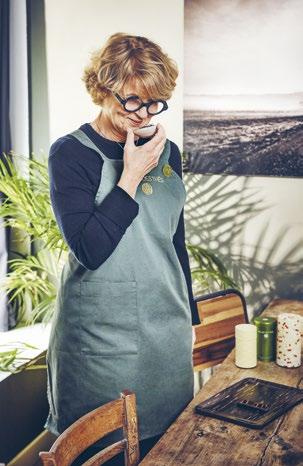
I took a circuitous route to Yunnan d’Or, via the world of perfume. When I chose to wear the fragrance Osmanthe Yunnan by perfumer JeanClaude Ellena, I had no idea of the wonderful discoveries that would await me ten years later. Perfumes, gardens and food – bridges between craft and art – were my main interests. When I began my relationship with tea just over four years ago, I was delighted to discover that this region, where I’ve always dreamed of traveling, is home to aromatic, flavorsome treasures worthy of the finest restaurants! Yunnan d’Or is one of them. As the warmer weather arrives, why not try it infused at room temperature?
Before I brew a tea, I like to look closely at its leaves as I reflect on the producer’s expertise. These leaves are deep brown, long and twisted, with tawny tips. In my mind’s eye I see a field of bright green tea bushes against a backdrop of white snow-capped mountains.
Then I smell the leaves. They hint at the rich profile of this black tea, with honeyed and spicy notes. I place the leaves
in a glass teapot and pour in room-temperature water [1] . I enjoy watching the water gradually take on its color [2]. After one hour of brewing, I filter the tea. I like to present and serve it in beautiful objects that are special to me. I pour out the amber, clear, gleaming infusion that shines like gold [3] . I raise the cup to my mouth. The aromas promise a smooth tasting. For those who know hot-brewed Yunnan d’Or, with its animal notes of leather and polished wood, this cold brew will seduce you with its delicate yet intense floral, honeyed flavors.
Prepared this way, it is the ideal drink to enjoy throughout the day. With a lower caffeine content, I enjoy it in the evening too, when it takes on a special

flavor as I listen to Debussy’s Clair de Lune. This extra layer of emotion inevitably makes me think gratefully of the producer of this wonderful Dian Hong tea.
Yunnan d’Or, Perfect With Food
Ideal for breakfast, Yunnan d’Or
can also be served with a meal. Your guests will enjoy it with every course, from starter to dessert: with pâté; with roast duck breast and roast sweet potato con fit; with a hard cheese such as a Comté or Hercule, or a soft sheep’s or goat’s cheese from the Haute-Garonne; with a pear tart. For this purpose, the tea is brewed in the Western style at 90°C for four minutes. Serve in glasses to enhance the effect.

The Poetry of Yunnan d’Or
“Tea is a perfume to drink”. These beautiful words, uttered by Mathilde Laurent, the Cartier nose, perfectly encapsulate the delicate bouquet of Yunnan d’Or. And like any perfume, this black tea has an incredible evocative quality. The teapot is like an Aladdin’s lamp: it takes me back to the summers of my childhood, at my grandmother’s
house in Normandy, where the smell of polished furniture and cakes baking in the oven was synonymous with happy times. •
Yunnan d’Or ORGANIC
Origin Yunnan (China)
Harvest Spring 2022
Brewing tips
→ Room-tempeR atuRe
infusion: 1 hr,
20g of tea per 1L water
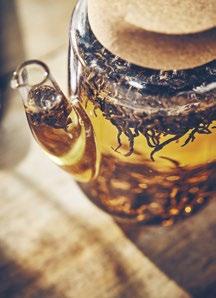
→ GonG fu cha (gaiwan) : repeated infusions
→ hot: 4 min at 90°C
FOOd pairings
Fresh goat’s cheese, financier (room temperature), roast duck breast, Beaufort d’été cheese (hot)
→ Ref. 2110 – € 19.90 per 100g
2. The infusion gradually takes on color. 3. The filtered infusion, a gleaming amber color, is served in a glass.A blend of green tea and toasted brown rice, this traditional Japanese tea is the perfect complement to the round, roasted notes of buckwheat noodles.
Serves 4
70g Genmaicha Yama
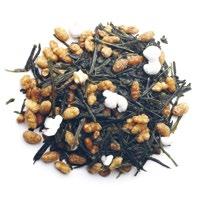
3 carrots
1 radish (red, daikon, blue meat, etc.)
100g sugar snap peas
200g shiitake mushrooms
300g pack soba noodles
2 tbsp sesame oil
2 green onions
Sprig of shiso
Salt
1. Brew the Genmaicha Yama in 1L of water at 75°C for 2-5 minutes. Remove the filter containing the tea and set the infusion aside for cooking the soba.
2. Peel the carrots and radish. Slice the radish with a mandolin. Rinse the vegetables.
3. Cook the sugar snap peas in a pot of boiling salted water for 3 minutes. Drain and cut in half.
4. Halve and thinly slice the carrots. Cook the carrots in boiling salted water for 4 minutes. They should still be crunchy. Drain and set aside.
5. Slice the mushrooms. Stir-fry them in 1 tbsp of sesame oil in a wok over high heat for 10 minutes. Stir frequently and add salt at the end of cooking.
6. Pour the tea infusion into a large saucepan. Bring to a boil and add the soba noodles. Check the cooking time on the packet. Remove the noodles from the heat 2 minutes before the time indicated on the packet to prevent them from becoming too sticky. Drain the noodles.
7. Add the other vegetables to the wok and stir. Add the soba noodles and a tablespoon of sesame oil. Stir again and cook for 2 minutes.
8. Chop the green onions and shiso and sprinkle them over the wok.



The traditional Japanese cast-iron teapot is a refined, precious object to be cherished throughout a lifetime of tea drinking. They come in all sizes and colors and can be handed down through the generations. They add a special flavor to every pot of tea. But the cast-iron teapot has not always been used in this way.
By Elena Di BenedettoThe first cast-iron pots for tea were made in China in the fourth century BC, but they really became popular in Japan in the twelfth century, when skilled artisans were crafting the finest examples in Iwate, in the north-east of the Japanese island of Honshu, a region that has everything necessary for quality production: iron, coal, clay, and sand. Cast-iron kettles were popularized in the sixteenth century by the Japanese prince Nanbu Toshinao. From
being an everyday object, they gradually became an essential part of tea preparation in Japan and then the rest of the world. To understand their popularity, we must examine their history. Before being used to brew and serve tea, as they are today, cast iron teapots were kettles. Called tetsubin, these highly functional vessels were placed directly on the fire to boil several
Cast iron is a brilliant alloy of iron and carbon. When the carbon content exceeds three percent, the metal becomes steel. Cast iron is very strong and retains heat, making it a valuable material for brewing tea.
liters of water, thanks to the excellent heat diffusion properties of cast-iron. When they were discovered by Westerners in the nineteenth century, their similarity to European teapots, with their spout, handle and lid, led them to be used in the same way. From being utensils used for heating water, these cast-iron pots became status symbols, reserved for brewing and serving tea.
Today, Japanese cast-iron teapots are still made in the traditional way. Each foundry has its own closely guarded production secrets. The foundryman makes different molds from clay
or compressed sand, between which the molten iron is poured. Each mold corresponds to a different part of the teapot. The outer mold, which features the pattern (often plant motifs), is the most demanding, requiring between 2,500 and 3,000 operations. The inner mold will form the body of the teapot. For high-quality teapots, a mold is used only once and then broken with a hammer to reveal the metal inside. The craftsman forges the handle directly in the flames. The teapot is then fired in a charcoal kiln at 800°C, which gives it its beautiful black color. The cast iron may then be enameled to prevent it from rusting. The final stage is the pigmentation, which creates a delicate patina that is unique to that teapot. This long and detailed process can take several days or even weeks.

While cast-iron teapots can be found in the homes of many tea lovers around the world, the way they are used varies from country to country. The Japanese

still allow their non-enameled teapots to rust. They don’t consider this a health hazard; on the contrary, they believe it adds iron to their diet. In the West, however, rust is not considered a good partner for tea, so most imported models have glazed insides to seal the surface and eliminate the need to season the teapot 1 . Over time, successive deposits of tannins can form a black deposit, but this doesn’t affect the flavor of the tea and will flake off on its own if the teapot is left to dry for a few days. These teapots have a short “memory” and can be used to
This foundry in the Yamagata region has been in operation since 1604. It is named after a very high-quality cast iron that was used in Japan until the Edo period to make swords. Today, only a few workshops still make teapots from this extremely pure cast iron.
brew a variety of teas. In terms of brewing, there is an important detail: cast iron retains its heat for a long time and is therefore likely to influence the way the infusion develops in the teapot. This means it is important to follow the recommended brewing times, to allow the teapot to bring out all the flavors of each tea, so you can enjoy it at its best. •
RULE NO. 1
Never leave water or tea in the teapot for a long time after brewing.
RULE NO. 2
Rinse with clear, lukewarm water after each use, and never use detergent.
RULE NO. 3
Allow the teapot to air dry without a lid. Store it when it is completely dry.
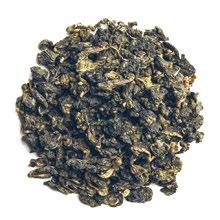
A semi-oxidized tea from a little-known region, Jade Oolong reveals elegant floral and vanilla notes. Journey to south-east Asia with these tea pearls that blur boundaries when tasted and are particularly reminiscent of some Taiwanese Oolongs.
Between sea and mountain, on the volcanic island of Java, the organic Jade Oolong digs its roots into the slopes of Mount Halimun in south-west Jakarta. Shrouded in mist at an altitude of 1,000 meters, this tea bush native to Taiwan has long leaves that are delicately rolled.
Indonesia was an object of colonial desire from the fifteenth century for its wealth of spices. It wasn’t until the early nineteenth century that it became a land of tea. Camellias have bloomed in Jakarta since the seventeenth century, but only for ornamental purposes! Then in 1877, Assamica tea seeds were brought to Sri Lanka to improve the quality of production for local consumption, which gradually spread internationally. Today, tea plants cover more than 296,000 acres of the country, with an annual production of 143,300 US tons. With its high mountains, mineral-rich volcanic soil, exceptional
biodiversity, and tropical climate, the Indonesian archipelago offers ideal conditions for growing tea. But of the thousands of islands that make up the archipelago, almost all of the tea is grown on Java. While the majority of lowland teas are destined for mass consumption due to their low quality, a few high-altitude teas stand out thanks to the work of passionate producers who harness the characteristics of their exceptional terroir of humid jungles and seismic zones. Indonesia has long been underestimated as a tea producer but is now coming to prominence with, for

example, this incredibly appealing Oolong.
Both visually and flavor-wise, this organic Jade Oolong is reminiscent of the famous Dong Ding from the Taiwanese province of Nantou. This is hardly surprising, as the cultivars planted on the slopes of Mount Halimun, as well as the production method, are actually from Taiwan. In Java, on the family farm that produces Organic Jade Oolong, they
are experimenting with these imported practices, favoring organic farming, committed to impeccable quality, and seeking to reveal sweet, deep notes. The Taiwanese influence is strong in this unique Javanese tea, especially in the method of production. The tea leaves are steamed five, six, or seven times, then rolled into tight bundles and pressed between two discs to form the pearls characteristic of certain Oolongs.
Once brewed, this Organic
Jade Oolong produces a golden infusion. The lush notes of this medium-oxidized tea bring out its creamy texture and delicate sweet flavor. On tasting, it evokes the pleasure of sharing a dessert. The vanilla and milky notes encourage a moment of delicious appreciation, especially when paired with a crème caramel for its wonderfully complementary flavors.
The flavor profile makes this Organic Jade Oolong an excellent alternative to Dong Ding. We will soon be withdrawing the latter to reflect our policy of promoting organic teas. •

Would you like to know more about Indonesian teas? Join François-Xavier Delmas and journalist Sidonie Bonnec as they explore the archipelago in this episode of their podcast Un thé, un voyage (in French).
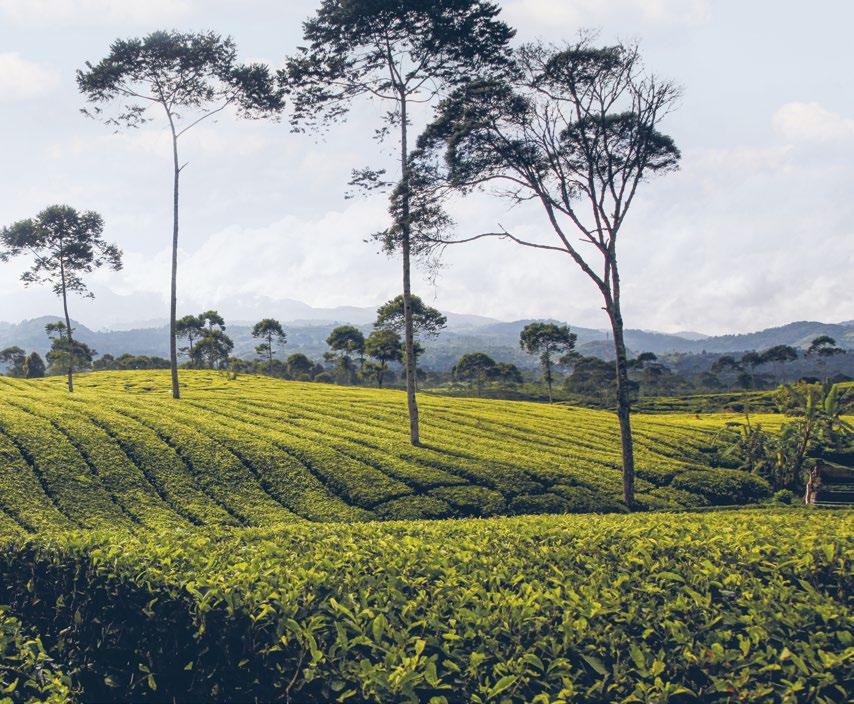
To help the Kalapani farm obtain organic certification, Félix and Jean, agricultural engineers from AgroParisTech and the École Supérieure des Agricoles d’Angers, spent four months with them in Nepal.

Félix and Jean brought their scientific knowledge and worked with the team on a daily basis to implement best practices and help the Kalapani estate overcome the problems it faces. Their presence on the ground has helped define a common mission: to identify a
disease affecting the tea leaves and improve yields by treating the pests. This is essential support for Kalapani Tea Industries, which is paving the way for organic certification!
In April, we published our very first CSR report, setting out everything we are doing to achieve responsible growth, which is not achieved at the expense of the planet and should benefit everyone. We have given ourselves until 2026 to fulfill the commitments we have made to our producers and our employees, as well as in terms of the environment, civic responsibility, and community support. For us, it is essential to be useful. With this document, we humbly present our intentions and achievements, marking a milestone from which we will continue to make progress together.
In 2020, we committed to converting all our teas to organic. Making this transition for Limoncha and all of our flavored blends takes time, as each one must be made with at least 95% organic ingredients. It took us nine months to find the right balance and bring you a tea that you loved during its limited release for Christmas 2021. Now, Limoncha is available loose leaf from early July!




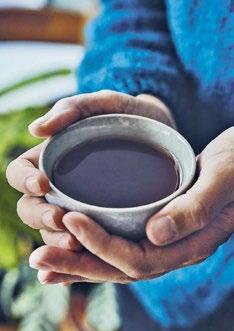
Yunnan Buds
→ Ref. 2250 – € 36 per 100g
This is a Dian Hong Cha, a Chinese black tea from Yunnan province. This exceptional plucking consists exclusively of highly aromatic slender golden buds that produce an infusion with pronounced woody, honeyed, fruity, and animal notes.

Jasmin Céleste de Guiyangshan
→ Ref. 2084 – € 48 per 100g
This delicate white jasmine tea is shaped into pearls. From Fujian, it releases an elegant bouquet of floral and fruity notes.
Conceived as experiences that awaken all five senses, Les Sources infusions allow you to replenish your spirit with positive energy. An innovative approach to self-care that combines sensations with beneficial plants, for those who want to take some time for themselves!

1. On A Cloud oRGanic
→ Ref. D9310N – € 14 for a box of 20 tea bags
2. The Sound Of Waves oRGanic
→ Ref. D9300N – € 14 for a box of 20 tea bags
3. Pure Joy oRGanic
→ Ref. D9320N – € 14 for a box of 20 tea bags
4. The Sound Of Waves oRGanic
→ Ref. DV9300Z – € 18.40 for a 90g metal caddy
5. On A Cloud oRGanic
→ Ref. DV9310Z – € 18.40 for a 100g metal caddy
6. In My Bubble oRGanic
→ Ref. DV9330Z – € 19.90 for a 140g metal caddy
7. Pure Joy oRGanic
→ Ref. DV9320Z – € 18.40 for a 100g metal caddy
8. Source cup (40 cl)
→ Ref. N317 – € 12
1. Iced tea gift box
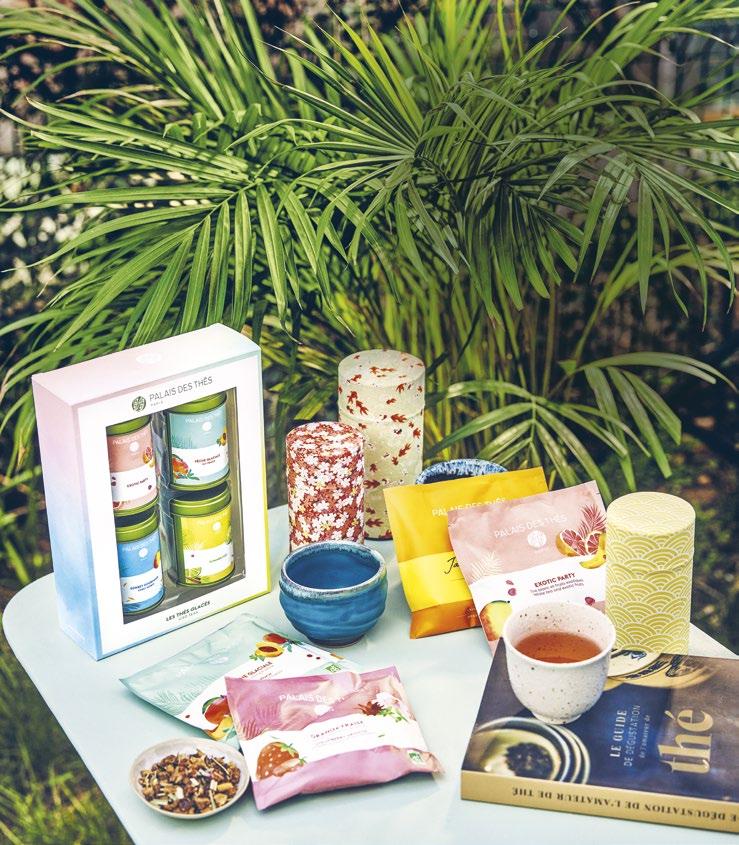
→ Ref. DBM19 – € 26.90
MULTI-SACHETS
2. Icy Peach
→ Ref. DTG8370 – € 6.90
3. Strawberry Granita
→ Ref. DTG8410 – € 6.90
4. Tropical Garden
→ Ref. DTG962 – € 6.90
5. Exotic Party
→ Ref. DTG812 – 6.90 €
LOOSE LEAF
6. Strawberry Granita
→ Ref. 8410 – € 13 per 100g
WASHI CADDIES
7. Hanami
→ Ref. V2056B – € 13 for a 100g caddy
8. Nishikigoi
→ Ref. V2053C – € 16 for a 150g caddy
9. Rising Sun
→ Ref. V2055C – € 16 for a 150g caddy
10. Okinawa cup – stoneware by Mr Mizuno (12 cl)
→ Ref. N312 – € 20
11. Sand cup - porcelain by Mr Mizuno (12 cl)
→ Ref. N310 – € 16
12. Le Guide de dégustation de l’amateur de thé (The Tea Drinker’s Handbook)
→ Ref. L027B – € 24.95
Bruits de Palais
A publication from Palais des Thés
Editorial team
Bénédicte Bortoli, Chloé Douzal, Mathias Minet
Art direction and layout
Laurent Pinon and Aurore Jannin for Prototype Design
Sarah Vasseghi
Illustrations
Stéphane
Humbert-Basset
Translation
Marta Scott
Proofreading
Nicole Foster
Palais des Thés
All translation, adaptation and reproduction rights in any form are reserved for all countries.
Photo credits Palais des Thés photo library – François-Xavier Delmas: cover, p.2, 4, 6, 10-11, 12, 13, 20-21,
23, 24, 25, 33, 39 •
Guillaume Czerw: p.16, 26, 27, 29, 36, 37, 38
• Prakash Raya: p.34
• Kenyon Manchego: p.28, 35.
Customer service
+33 (0)1 43 56 90 90
Cost of a local call (in France)
Monday to Saturday 9am-6pm
Corporate gifts
+33 (0)1 73 72 51 47
Cost of a local call (in France)
Monday to Friday 9am-6pm
Find
Tea plants often grow on the mountainsides. This means their roots don’t sit in water, as the rain runs off the slopes.
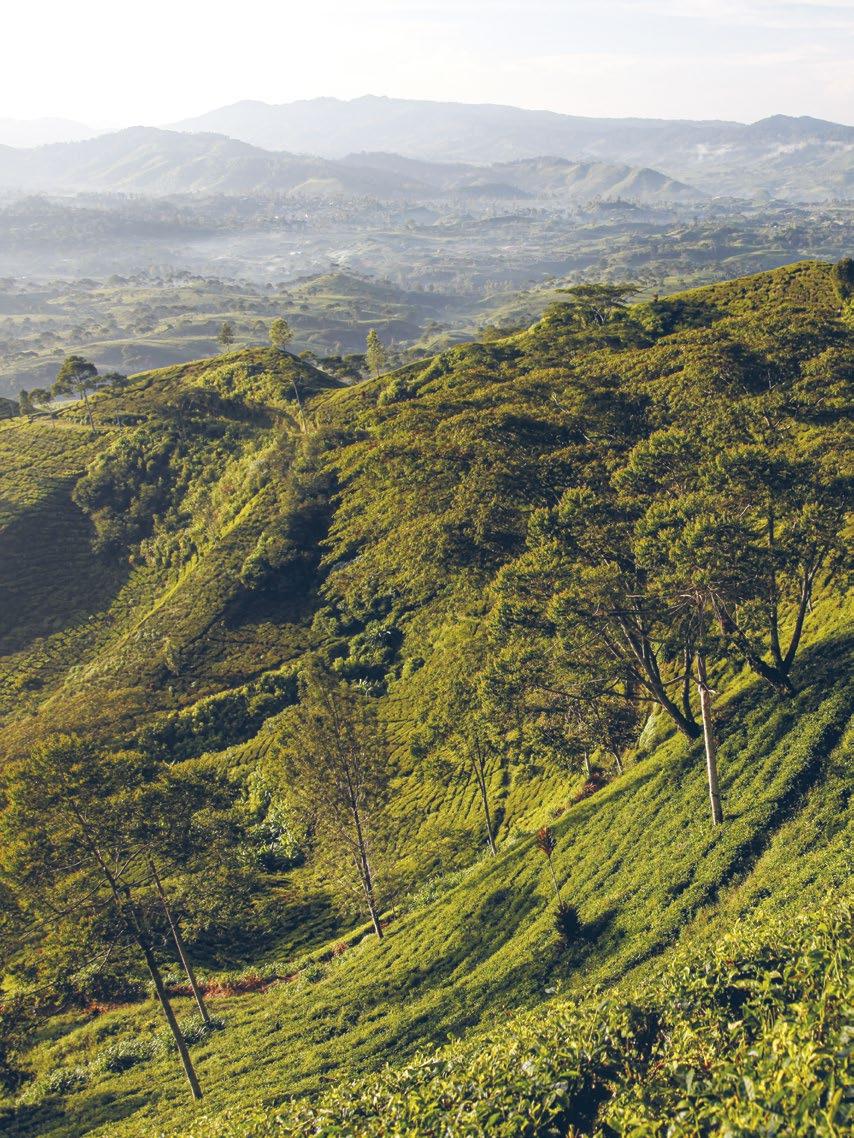
“We Orientals tend to seek our satisfactions in whatever surroundings we happen to find ourselves. […] We will immerse ourselves in the darkness and there discover its own particular beauty.”
Jun’ichirō Tanizaki In Praise of Shadows